#: Marceline Noir
Text
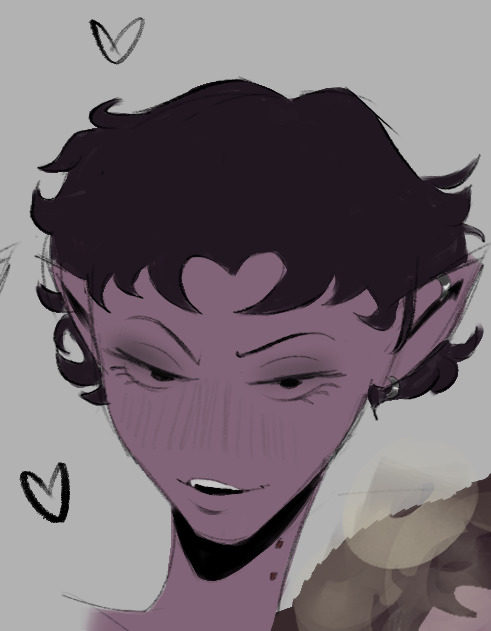

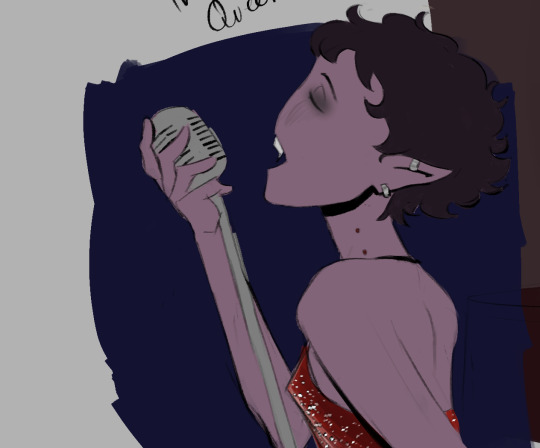
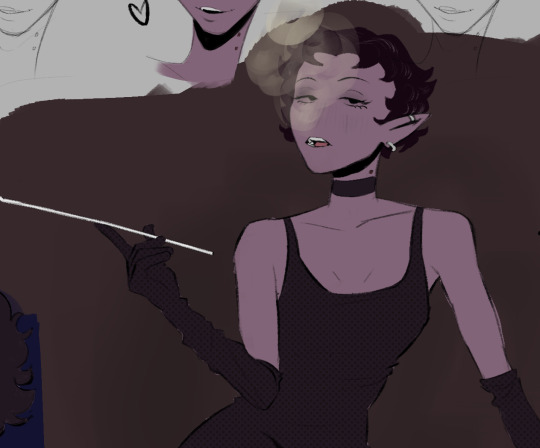
Bubbline Noir AU pt. 2
Marceline "The Vampire Queen" Abadeer
Marceline is a jazz singer at the underground, speakeasy, the Nightosphere, which operates under the protection of the Candy Kingdom mob. PB is def a regular around here, mostly overseeing business and conducting meetings.
#bubbline#marceline#marceline abadeer#at#adventure time#sugarless gum#selsdraws#i draw stuff#Mafia!Bubbline#Noir AU#yeah this was fun teehee#ALSO IF ANYONE AS ANY MORE IDEAS pls lmk this is all just for fun!!#Mafia!marceline
401 notes
·
View notes
Text
HAPPY PRIDE MONTH!!!!
#wenclair#caitvi#rupphire#lumity#bumbleby#catradora#korrasami#bubbline#kyosaya#madohomu#kittybella#marigami#wednesday x enid#caitlyn x vi#ruby x sapphire#luz x amity#blake x yang#catra x adora#korra x asami#bubblegum x marceline#kyoko x sayaka#madoka x homura#scarabella x kitty noir#marinette x kagami#poll#polls
48 notes
·
View notes
Text

#come along with me#Oc#art#illustration#dessin#drawing#character#sketch#blackandwhite#Noir et blanc#Adventure time#marceline#ms paint#js paint#Paint
7 notes
·
View notes
Text
I've been binging Adventure Time recently, so I decided to draw some silly Miraculous doodles in its art style.

#traditional art#fanart#miraculous ladybug#miraculous#mlb#ml#miraculous fanart#mlb fanart#marinette dupain cheng#marinette#ladybug#chat noir#cat noir#hawk moth#nathalie sancoeur#marceline#marceline the vampire queen#adventure time#adventure time fanart
10 notes
·
View notes
Text
Hi everyone!
We are a system looking for potential friends. Aside from that, we also have a few kins (not kin for fun) and I’ll list the main ones here:
Marceline from Adventure Time
Adrien from Miraculous
Sydney from I Am Not Okay With This
Kenny from South Park
Please feel free to interact! We’d be more than happy to talk! We’re also more than happy to discuss kin memories and meet canonmates!
(This post may be updated)
0 notes
Photo

Ships
Unexpected connections happen in two places: the Ships list and Feeld—a dating app for the curious. On Feeld, finding like-minded people is as fulfilling as finding yourself. In celebration of ships, here are this year’s iconic connections.
Ineffable Husbands +17
Aziraphale & Crowley, Good Omens
Steddie
Steve Harrington & Eddie Munson, Stranger Things
Destiel
Dean Winchester & Castiel, Supernatural
Byler -3
Will Byers & Mike Wheeler, Stranger Things
Wenclair
Wednesday Addams & Enid Sinclair, Wednesday
Bowuigi
Bowser & Luigi, the Super Mario Bros. franchise
Huntlow +7
Hunter & Willow Park, The Owl House
Avatrice
Ava Silva & Beatrice, Warrior Nun
Hannigram +2
Hannibal Lecter & Will Graham, Hannibal
Buddie -4
Evan Buckley & Edmundo Diaz, 9-1-1
Vashwood
Vash the Stampede & Nicholas D. Wolfwood, Trigun Stampede
Zelink +80
Zelda & Link, The Legend of Zelda
Lumity -6
Luz Noceda & Amity Blight, The Owl House
Ghostsoap
Simon “Ghost” Riley & John “Soap” MacTavish, the Call of Duty franchise
Blackbonnet -11
Edward Teach/Blackbeard & Stede Bonnet, Our Flag Means Death
Wolfstar +8
Remus Lupin & Sirius Black, the Harry Potter universe
Merthur +12
Merlin & Arthur Pendragon, Merlin
Jegulus +25
James Potter & Regulus Black, the Harry Potter universe
Bumbleby +48
Yang Xiao Long & Blake Belladonna, RWBY
Bakudeku -4
Bakugou Katsuki & Midoriya Izuku, Boku no Hero Academia
Dreamling -1
Dream of the Endless & Hob Gadling, The Sandman
Soukoku +60
Nakahara Chuuya & Dazai Osamu, Bungou Stray Dogs
Firstprince
Alex Claremont-Diaz & Prince Henry of Wales, Red, White & Royal Blue
Wesper
Wylan Van Eck & Jesper Fahey, the Grishaverse
Wangxian -8
Lan Wangji & Wei Wuxian, Mo Dao Zu Shi
Satosugu +23
Gojo Satoru & Geto Suguru, Jujutsu Kaisen
Imodna +8
Imogen Temult & Laudna, Critical Role
Kanej +44
Kaz Brekker & Inej Ghafa, the Grishaverse
Bubbline
Princess Bubblegum & Marceline, Adventure Time
Ladynoir -17
Ladybug & Chat Noir, Miraculous: Tales of Ladybug & Cat Noir
Twiyor +6
Loid Forger & Yor Forger, SPY x FAMILY
Loustat +43
Louis de Pointe du Lac & Lestat de Lioncourt, Interview with the Vampire
Zosan
Roronoa Zoro & Vinsmoke Sanji, One Piece
Marichat -12
Marinette Dupain-Cheng & Chat Noir, Miraculous: Tales of Ladybug & Cat Noir
Serirei +65
Serizawa Katsuya & Reigen Arataka, Mob Psycho 100
Adrienette -21
Adrien Agreste & Marinette Dupain-Cheng, Miraculous: Tales of Ladybug & Cat Noir
Chenford +24
Lucy Chen & Tim Bradford, The Rookie
Petrigrof
Simon Petrikov & Betty Grof, Adventure Time: Fionna and Cake
Kavetham
Kaveh & Alhaitham, Genshin Impact
Griddlehark +54
Gideon Nav & Harrowhark Nonagesimus, The Locked Tomb series
Raeda -13
Raine Whispers & Eda Clawthorne, The Owl House
Tomgreg -19
Tom Wambsgans & Greg Hirsch, Succession
Hanamusa
Jessie & Delia Ketchum, the Pokémon franchise
Zolu
Roronoa Zoro & Monkey D. Luffy, One Piece
Narumitsu -12
Phoenix Wright & Miles Edgeworth, Ace Attorney
Sonadow +23
Sonic & Shadow, Sonic the Hedgehog
Ineffable Bureaucracy
Archangel Gabriel & Beelzebub, Good Omens
Spirk +9
Spock & James Kirk, Star Trek
Ballister x Ambrosius
Ballister Boldheart & Ambrosius Goldenloin, Nimona
Nandermo -42
Nandor the Relentless & Guillermo de la Cruz, What We Do in the Shadows
Jonmartin -15
Jonathan Sims & Martin Blackwood, The Magnus Archives
Punkflower
Hobie Brown & Miles Morales, Spider-Man: Across the Spider-Verse
AkiAngel
Aki Hayakawa & the Angel Devil, Chainsaw Man
Ronance -49
Robin Buckley & Nancy Wheeler, Stranger Things
Superbat -11
Superman & Batman, the DC universe
Shuake
Ren Amamiya/Joker & Goro Akechi, Persona 5
Geraskier -48
Geralt of Rivia & Jaskier, The Witcher
Hualian -18
Hua Cheng & Xie Lian, Tian Guan Ci Fu
Sulemio
Suletta Mercury & Miorine Rembran, Mobile Suit Gundam: The Witch from Mercury
Sterek -5
Stiles Stilinski & Derek Hale, Teen Wolf
Gumlee
Prince Gumball & Marshall Lee, Adventure Time: Fionna and Cake
Shadowpeach
Sun Wukong & the Six-Eared Macaque, Lego Monkie Kid
Drarry -29
Draco Malfoy & Harry Potter, the Harry Potter universe
Wilmon
Prince Wilhelm & Simon Eriksson, Young Royals
Harringrove -34
Steve Harrington & Billy Hargrove, Stranger Things
Kazurei
Suwa Rei & Kurusu Kazuki, Buddy Daddies
Lestappen
Charles Leclerc & Max Verstappen, Formula 1 drivers
Zukka -5
Zuko & Sokka, Avatar: The Last Airbender
Codywan +8
Commander Cody & Obi-Wan Kenobi, Star Wars: The Clone Wars
Solangelo -23
Will Solace & Nico di Angelo, the Percy Jackson universe
Catradora
Catra & Adora, She-Ra and the Princesses of Power
Shadowgast -4
Caleb Widogast & Essek Thelyss, Critical Role
Stucky -43
Steve Rogers & Bucky Barnes, the Marvel universe
Tarlos -18
TK Strand & Carlos Reyes, 9-1-1: Lone Star
Johnlock +21
John Watson & Sherlock Holmes, Sherlock
Sasunaru -24
Uchiha Sasuke & Uzumaki Naruto, Naruto
Locklyle
Anthony Lockwood & Lucy Carlyle, Lockwood & Co.
Lokius
Loki Laufeyson & Mobius M. Mobius, the Marvel universe
Supercorp -67
Kara Danvers & Lena Luthor, Supergirl
Piltover's Finest
Caitlyn Kiramman & Vi, Arcane
Helnik
Matthias Helvar & Nina Zenik, the Grishaverse
Prohibitedwish
Scarab & Prismo, Adventure Time
Klance -12
Keith & Lance, Voltron: Legendary Defender
Reylo
Rey & Kylo Ren, the Star Wars universe
Hanazawa
Teruki & Kageyama Shigeo, Mob Psycho 100
Cockles -44
Misha Collins & Jensen Ackles, Actors
Percabeth -46
Percy Jackson & Annabeth Chase, the Percy Jackson universe
Astarion x Tav
Astarion & Tav, Baldur's Gate 3
Timkon
Tim Drake & Conner Kent, Young Justice
Davekat
Dave Strider & Karkat Vantas, Homestuck
Cynonari
Cyno & Tighnari, Genshin Impact
Creek
Craig Tucker & Tweek Tweak, South Park
Klapollo
Apollo Justice & Klavier Gavin, Ace Attorney
Style
Stan Marsh & Kyle Brovlofski, South Park
Korrasami -11
Korra & Asami Sato, The Legend of Korra
Bill x Frank
Bill & Frank, The Last of Us
Nick x Charlie -51
Nick Nelson & Charlie Spring, Heartstopper
Dreamnotfound -50
Dreamwastaken & GeorgeNotFound, Streamers
Dinluke -33
Din Djarin & Luke Skywalker, the Star Wars universe
Rhaenicent
Rhaenyra Targaryen & Alicent Hightower, House of the Dragon
The number in italics indicates how many spots a ship moved up or down from the previous year. Bolded ships weren’t on the list last year.
Explore your desires on Feeld. Within a safer, inclusive space, you can feel free to connect more intimately to yourself and others. Choose from over 20 gender and sexuality options and explore solo, or with a partner. Curious? Download the app today.
8K notes
·
View notes
Text

La Mode, Pl. 308, 15 juin 1833, Paris. Bonnet de dentelle noire orné d'une rose mousseuse. Redingote de mousseline brodée doublée de marceline et fermée par des noeuds de gaze de M. Lavigne.
The woman on the right is wearing a dress with gigot sleeves, a tippet, and bows decorating the skirt. She is wearing a lace cap decorated with a flower. The seated woman on the right is facing away from the viewer. She is wearing a dress of similar design. She is also wearing gloves and a lace cap decorated with flowers and is holding a bouquet of flowers in her right hand.
#La Mode#19th century#1830s#1833#on this day#June 15#periodical#fashion#fashion plate#color#description#lapl#dress#gigot#cape#collar
64 notes
·
View notes
Text
To celebrate RAINBOW!'s release today, I'm going to go over all the daydream references that have been made so far, since it's fun for me to sneak them in 💖 there's a lot of them though, so it's gonna be under the cut!
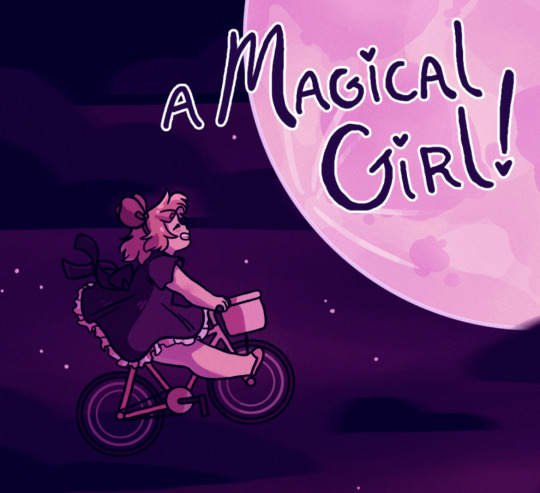

Episode 1-- Kiki's Delivery Service and E.T.! People focus on the Kiki reference so much that the other seemed to be missed.
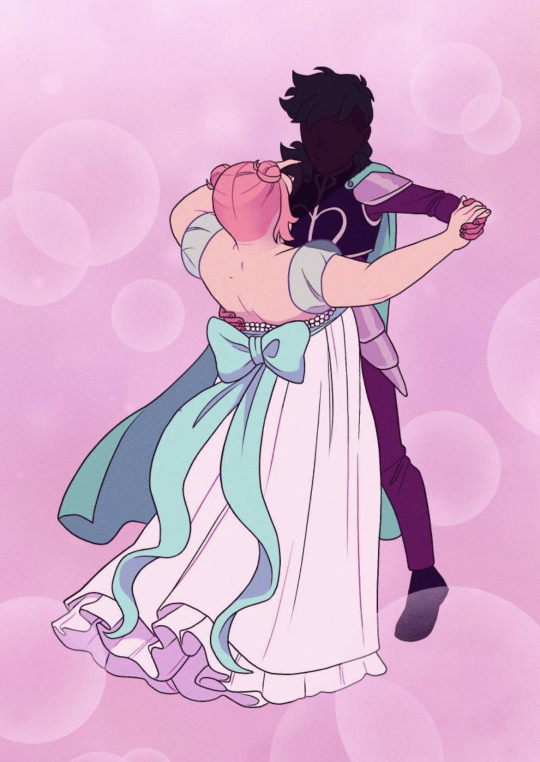
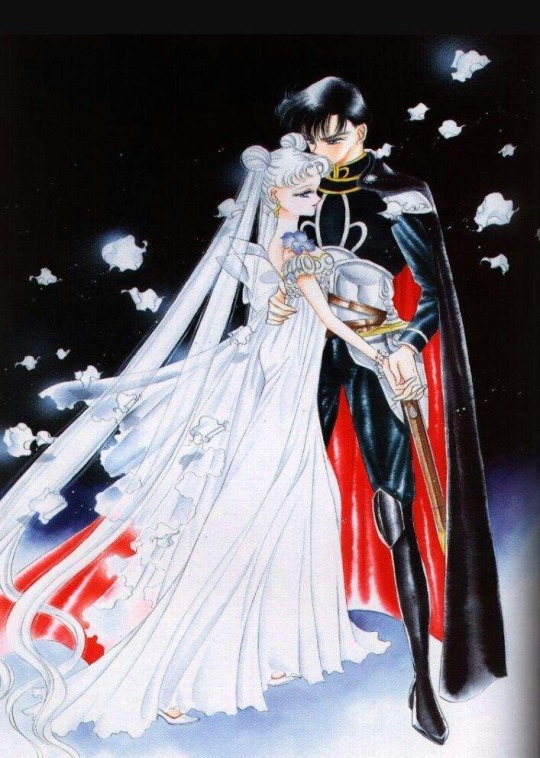
Episode 2-- Princess Serenity and Prince Endymion, Sailor Moon. Another one obvious enough to be called out in some comments. It was referenced again in episode 54, where this panel was taken from.
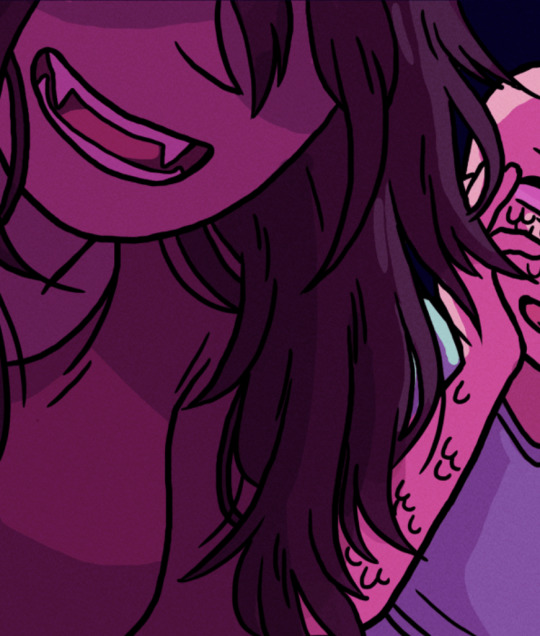

Episode 5-- Marceline, Adventure time. One of the few reference that isn't an outfit specifically, but a character.
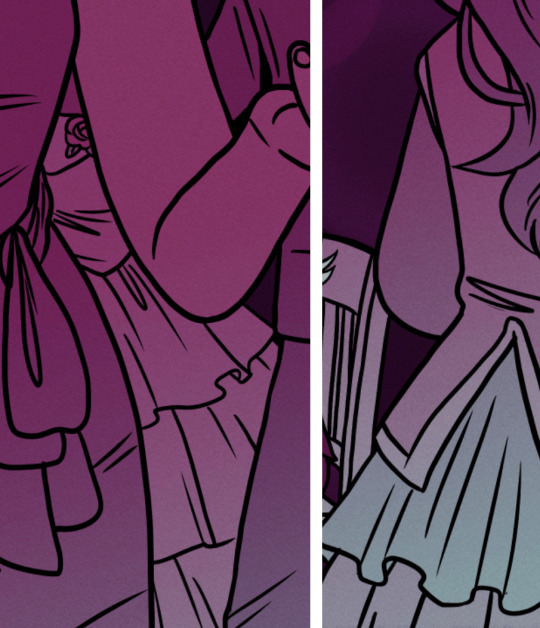

Episode 11-- Revolutionary Girl Utena. Not necessarily supposed to be the characters themselves, just the outfits.
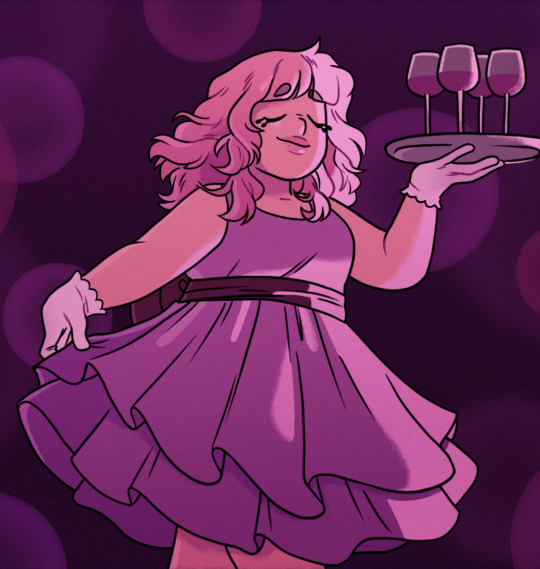
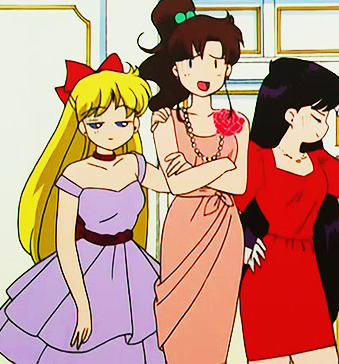
Episode 11-- Minako Aino, Sailor Moon. In hindsight, I don't remember why I chose this specific dress to reference and not the maid outfits from Sailor Stars or the fruits maid outfits from the manga... especially since I think the fruits maid outfits are adorable.
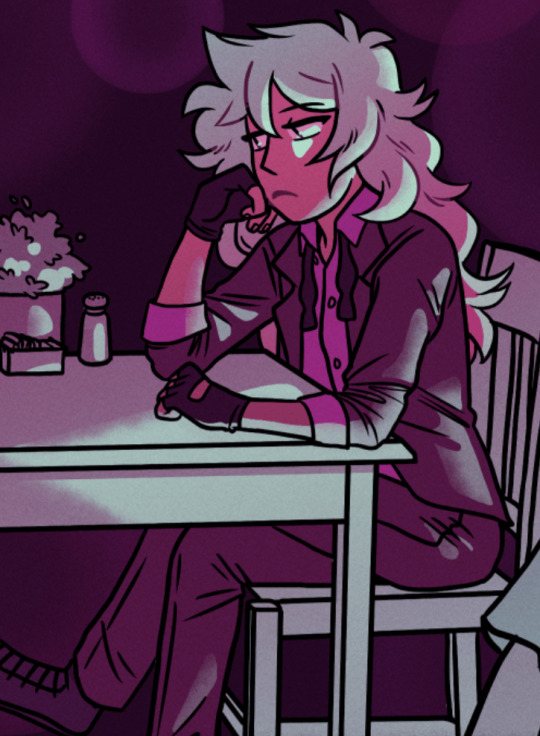

Episode 11-- Catra, She-Ra reboot. I kind of regretted this one immediately just because like 80% of the comments on the episode were "CATRA SUIT!!!" as a result...
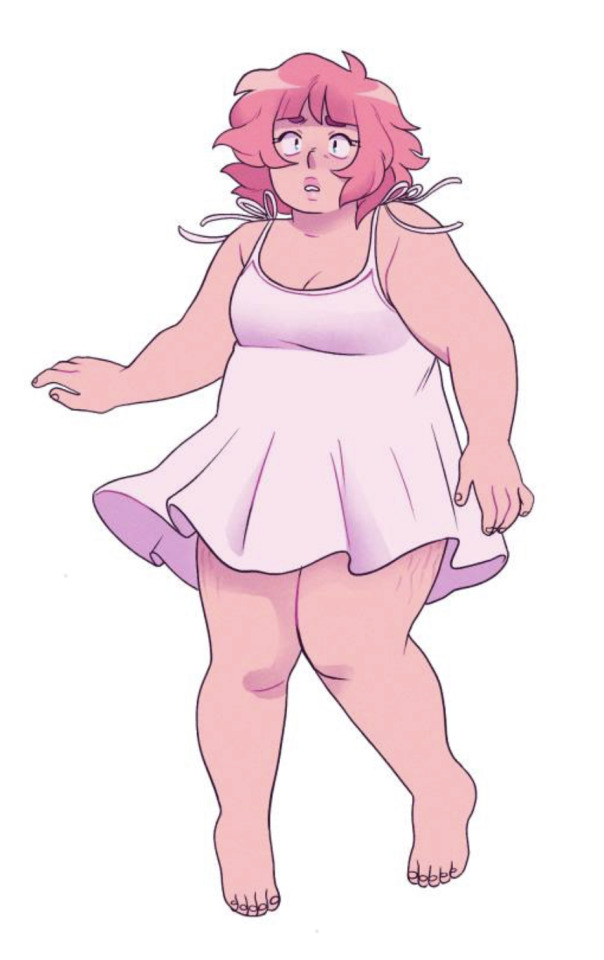
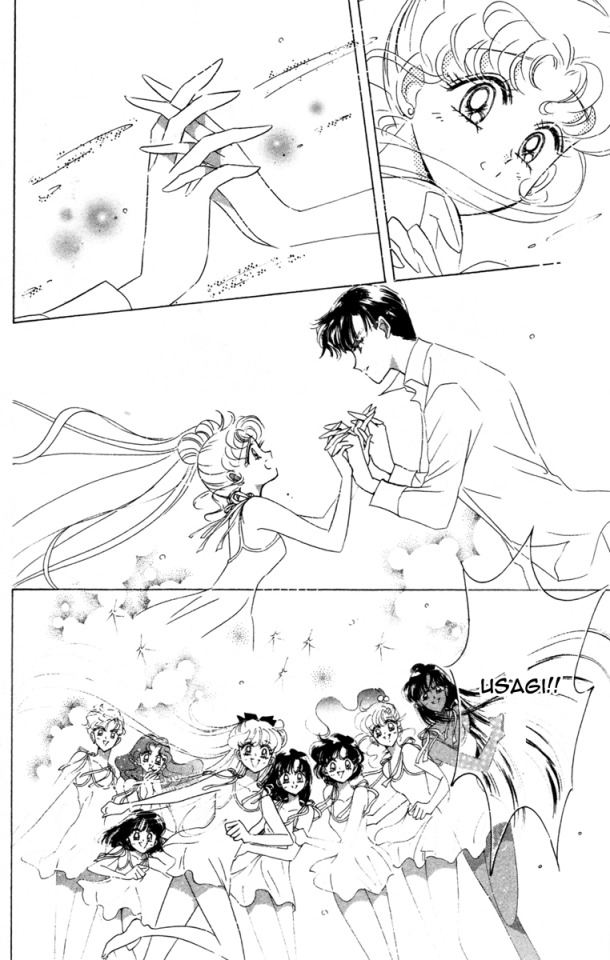
Episode 18-- Sailor Moon manga. I was always intrigued by the way characters would be dressed in dreamlike/ethereal sequences in the manga, so this reference was a must for me. I went with the version that is a full dress with straps rather than the dresses from other moments in the manga that have no discernible top half.
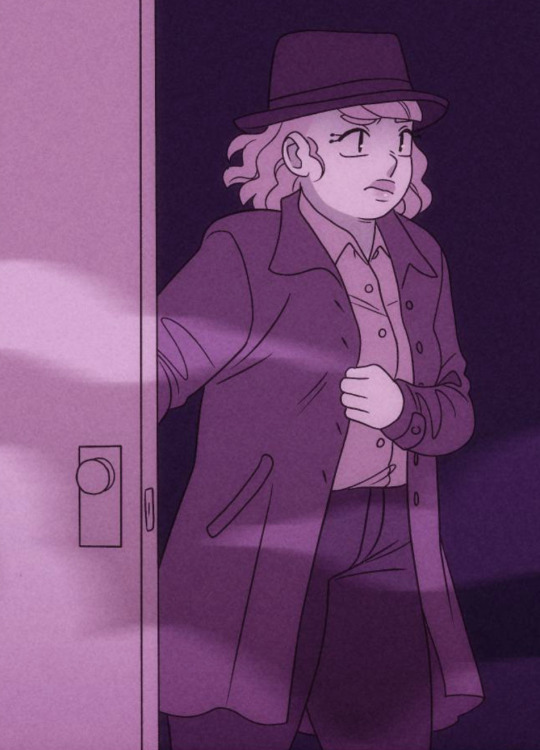

Episode 30 and 31-- Not a reference to any specific film or character, but just film noir in general. I do remember referencing a female character specifically for this but sadly I couldn't find it again.
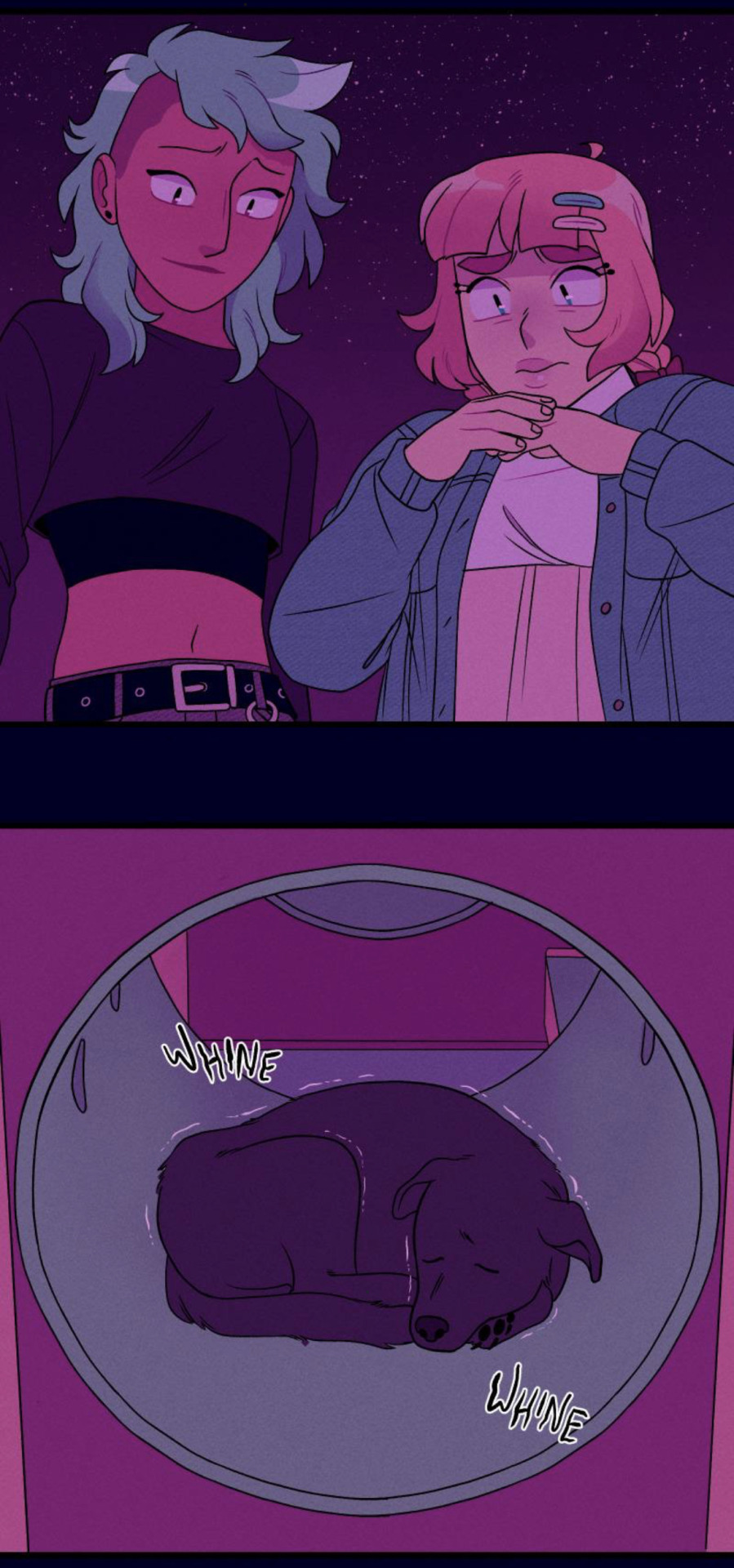

Episode 40-- Pomeranian scene, IT Chapter Two. Surely you saw this coming (or maybe not?) I don't think I got the camera angle good enough to really sell this reference, but I couldn't resist it anyways.
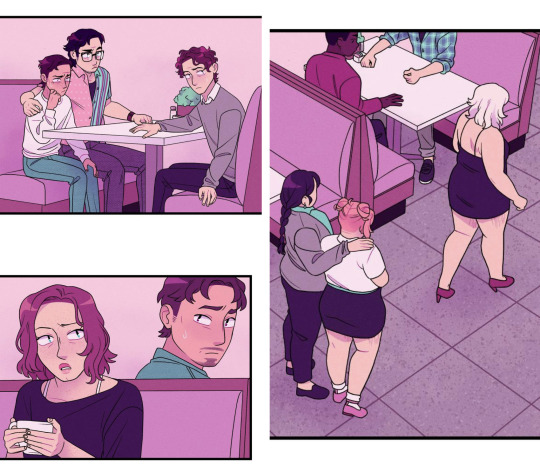
Episode 43-- Adult Losers, IT Chapter Two. The only reference besides Marceline that references the characters themselves, since I normally use our other characters for background character purposes. Also one of the only references that isn't a daydream.
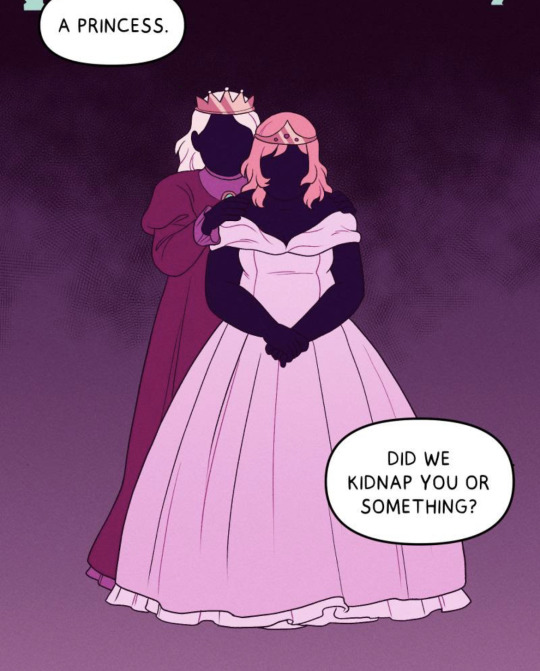


Episode 54-- Disney's Snow White and Cinderella. I couldn't decide which to reference, so I ended up leaning mostly into Cinderella, but referenced the Evil Queen's crown as well. Boo's dress is also somewhat referenced from the the live action Cinderella dress instead of the animated version, just because I liked it.
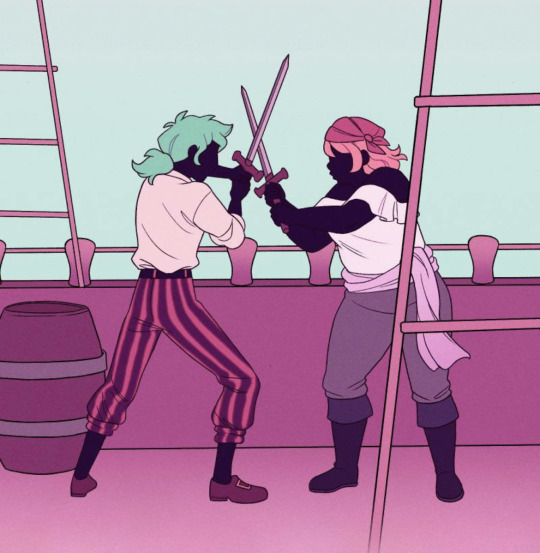

Episode 54-- Treasure Planet and Treasure Planet 2 concept art. Treasure planet is one of my favorite movies, so there was no way I was missing out on referencing it. A few people brought up some wlw pirate webcomic(s?) in the comments of this episode, but the actual reference seemed to be mostly missed. The sash around Boo's waist is also meant to be fabric from her princess dress in the previous panels.
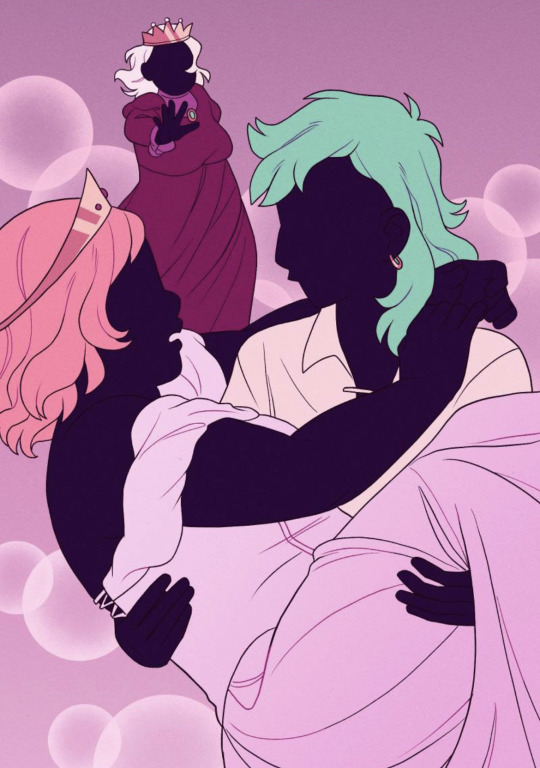

Episode 54-- Revolutionary Girl Utena. Another one I was kind of surprised wasn't called out just because of how iconic the whole clothed shadow/silhouette thing is.

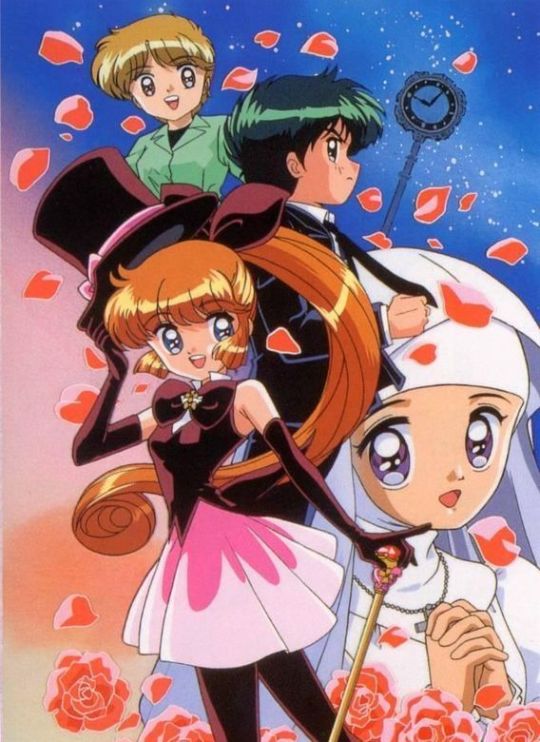
Episode 55-- Saint Tail. I couldn't reference this one as closely as I would have liked since it probably wouldn't have been very readable as a magician's costume to someone who didn't know it, so it mostly references the brooch from the anime and her hat.
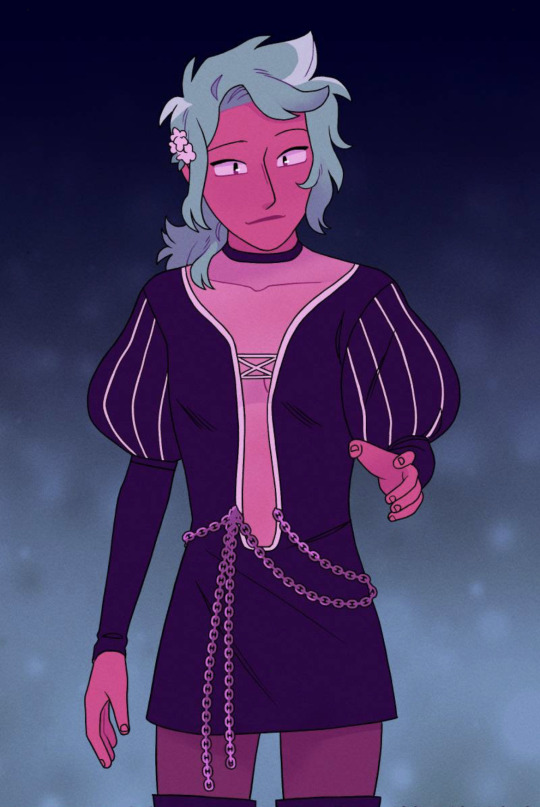
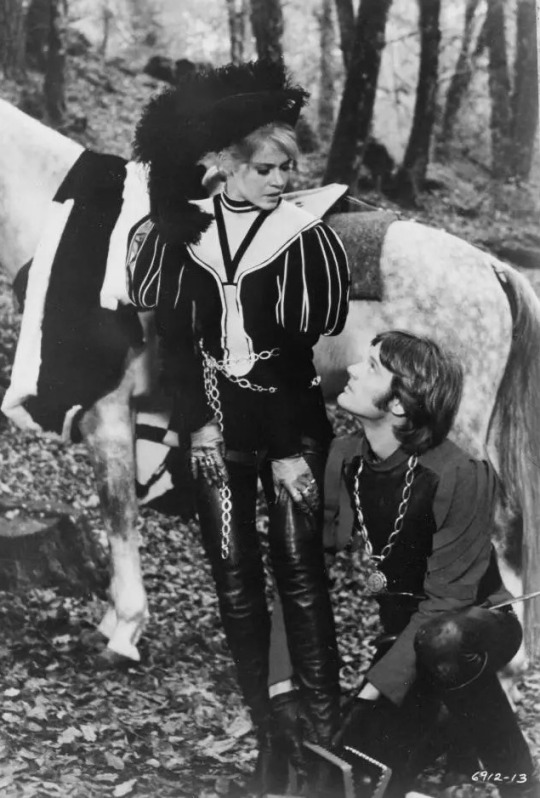
Episode 61-- Jane Fonda in Spirits of the Dead. A super random and out there reference, especially to end on, but I liked the outfit so much that I couldn't help it. Maybe Boo used to fall asleep to old movie channels, lol.
That's it, at least for now! We'll have to see what shows up in future episodes~
106 notes
·
View notes
Text
10 characters // 10 fandoms
rules: list 10 favourite characters from separate fandoms/media, then tag (10) people
tagged by @typhra :3 hewwo thank you
Team Rocket trio - Pokemon (i literally cant separate them. theyre all my favs)
Darrell - Ok Ko!
Space Boyfriend - Omori
Bonnie - In Stars and Time
Marceline - Adventure Time
Beast Boy - Teen Titans
Shadow the Hedgehog - Sonic
Cynder - Spyro
Nephrite/ Centipeetle - Steven Universe
Bec Noir - Homestuck
tagging: @bpdvulpine @galaxywarp @biocrafthero @bugmoment @caramel-bites
@knuckledust3r @voxbots @siffrin-enthusiast @branchifers @undeadpsychic
beloved mutuals!!! come hither posthaste!! a game for thee!! (if you want)
26 notes
·
View notes
Text
Regarding Hobie Brown crossovers(by a pastel punk/afrosolarpunk)
Full 'fence full shade full salt shaker,he wouldn't fuck with other superheroes just because they're superheroes if they're white and same goes for white punk characters.Yeah i'm serious.Hobie is afropunk.AFROpunk,very different from 'normal' punk,by which i mean whitewashed punk because afropunk is the ultimate punk as punk was created by black people.Him,Kat Elliot,Ekko,Kipo Oak and the Abadeer Twins(Marceline and Marshall Lee)are afropunks/black punks so they'd not only be best friends but consider eachother siblings.Duke Thomas is afropunk too and i think him and Hobie would be in love actually.Nimona is an exception because she's trans so the her and Hobie content is on-point and based asf and founded in canon because of his relathionship with Gwen Stacy(who is also an exception because she's trans and i see her as a black haired brown eyed biracial lightskin afrolatina but chile).Him and Ichigo Kurosaki are twinnin' and he'd tell him he has peak taste in gyals for loving Orihime Inoue who as a black pastel punk myself i count as pastel punk poc rep even if not in aesthetic.Katara is canonically a native punk girl who's probs trans and Aang is a tibetan genocide survivor who's gnc and literally invented decolonization in his verse so Hobie would ride with them no matter what.Hobie Brown and Luz Noceda are the 'black sunshines who stick with other weirdos and killed a fascist as a teenager' duo.This sounds stupid but Sonic The Hedgehog and Rainbow Dash would the Spiderham to his Noir
But speaking of which,he would NOT be instant best friends with Noir nor IS he.Noir is Peter Parker so he's white as shit,it's a no go and y'all are foul for romantic N*irpunk-They wouldn't beef or nothin' but they ain't friends,they co-workers.The entire MCU is also a big 'ol nope.Clark Kent's title before The Man Of Steel all way back in his debut was 'Champion Of The Oppressed' so Hobie would at LEAST have mad respect for him and Clark would treat him to cheeseburgers,loaded fries and milkshakes and tell him he's a real hero.He'd be best friends with Tim Drake because Tim Drake knows how to act and save him from poser punk by introducing him to Skapunk.'Cool Dude Jason Todd' is a lie frabricated by white cis fangirls and idc about him and Kon-El Kent/Superboy unless it's the popular black biracial headcanon for him and even then Clark needs to be the black one instead of Lex Luthor(i want that capitalist pig's head on a plate.)and if you think Duke's not a core Batkid Batboy and Robin because he's not a white blue eyed boy,Hobie would guitar your ass for even joking about it.I've headcanoned Stephanie Brown as blasian/jamaican-korean with black hair and brown eyes for years and have aus of/joke about her and Hobie being half siblings because of it and her last name and the him and Percy Jackson posting by me is largely brought on by the black Pjo fandom claiming Percy since the 2010s due to reading him afrolatino from the books alone with zero contradictions in-text and 'read' LITERALLY in a lot of cases,as in we thought he was canonically and Percy is also completely accurately punk and Stephanie's canonically pastel punk so there it is

Thanks for reading my infodump,here's a Hobietism creature
#hobie brown#hobie appreciation#atsv#spiderman#pastel punk tag#spiderpunks 2023#batfanon slander#kat elliot#ekko arcane#kipo oak#marceline abadeer#marshall lee abadeer#duke thomas#solarpunk(comics)#nimona#ichigo kurosaki#ichihime#katara#punk katara#aang#kataang#luz noceda#sonic the hedgehog#rainbow dash#clark kent#tim drake#kon-el kent#percy jackson#summerposting#stephanie brown
25 notes
·
View notes
Text








36 notes
·
View notes
Text
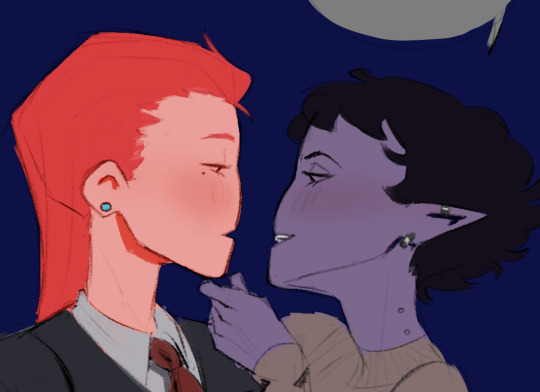
Bubbline Noir AU pt. 3
what are they even talking about...
#bubbline#princess bubblegum#marceline#marceline abadeer#adventure time#sugarless gum#noir au#just a quick sketch because i got bored of animating zzzz#selsdraws
162 notes
·
View notes
Text
Ok on the subject of Hynden Walch being amazing can we talk about AT’s voice cast? I feel like it doesnt get talked about nearly as much as it should.
Jeremy Shada is amazing for how he can escalate his voice for wacky moments or deescalate his voice for quieter, more thoughtful moments. Finn would not be the same character if it werent for Shada’s perfect vocal balance.
John Dimaggio, like what really needs to be said here? He’s BENDER! Of course he was amazing as Jake!
Hynden Walch was never really a voice I considered when thinking about how amazing AT’s voice cast was up until now, I really just remembered her because “hey thats Starfire!” But after hearing her performance as the Candy Queen I FEEL SO STUPID.
Olivia Olson…I wish I had something more constructive to say about Olsen’s voicework but I think everyone’s already well aware about how AMAZING she is as Marceline. Her voice is just so perfect for the character, being both good at delivering quips and devastating tearjerkers. And thats not even mentioning her having the single best singing voice to ever grace a western animated cartoon (yeah fuck you Alvin). Just like Jeremy Shada with Finn, I could not imagine Marceline without Olivia Olson.
Tom Kenny seems like he would be another Joe Dimaggio situation where hes one of the most amazing voice actors of the generation and thats all there is to say. But I think what makes Tom Kenny’s performance as Ice King AND ESPECIALLY SIMON so especially amazing is that…ITS TOM KENNY. THIS IS THE GUY WHO VOICES SPONGEBOB, AND HE’S RESPONSIBLE FOR THE VOUCE OF ONE OF THE MOST HEARTBREAKINGLY TRAGIC CHARACTERS IN ALL OF FICTION, AND HE DOES IT PERFECTLY. THE REVEAL IN HOLLY JOLLY SECRETS, THE CHEERS SCENE FROM SIMON AND MARCY, THE ENDING OF I REMEMBER YOU, ALL DONE BY THE SAME GUY WHO THOUGHT OF SOMETHING FUNNIER THAN 24*! THIS MAN IS A TREASURE.
Niki Yang, look, I know I already said that no one could play Marceline or Finn as well as Olson and Shada…BUT NO ONE, AND I MEAN, NO, ONE, COULD PLAY BMO AS WELL AS NIKI YANG. She brings a perfect tone of childlike wonder, curiosity and innocence into every word spoken by the little robot. She brings such a fun and vibrant energy to the little guy in episodes like “5 short graybles” or “BMO noire,” that just makes it hit all the harder when moments of existentialism pop up in episodes like “The More you Moe” or…well…”BMO.” BMO has one of the most interesting growing up stories in a series where every pretty much every character’s stories are about growing up, and a lot of that is owed to how perfectly delivered his lines are by Yang.
But theres one voice that gets overlooked more than most others, and who deserves way more credit than they get for how important they are to the show. Someone who’s been around since the very first episode and has been continually providing voices for the series even now in Fionna and Cake. A voice actress whos so commited to the show that its easier to count the episodes she ISNT in than the ones she is in. MARIA. BAMFORD. Margaret, Hot Dog Princess, Slime Princess, Ghost Princess, Melissa, Raggedy Princess, Manfried, Wildberry Princess, Undead Princess, The Butterfly with a Gun AND AN ABSOLUTELY GINORMOUS AMOUNT OF EXTRA VOICES. She puts so much of her signature hilarious vocal range into every one of the dozens if not HUNDREDS of characters that she plays throughout the series. Also a lot of you probably don’t know this but she does standup comedy and she’s hilarious and you should all listen to her albums because she also does funny voices in that and you can even sometimes identify a voice she used for a character in the show…but also trigger warning for mental illness and suicide she talks about those kind of a lot. But anyway my point is, Maria Bamford is a huge reason as to why Adventure Time is as wonderful as it is. Her wacky voices contribute so much to the weird and wonderful vibe of the show, and even if she doesn’t play any primary characters, she is one of the most important and under appreciated voices in the entire series.
*25
#fionna and cake#adventure time#finn mertens#jake the dog#princess bubblegum#marceline#ice king#simon petrikov#bmo#jeremy shada#john dimaggio#hynden walch#olivia olson#tom kenny#niki yang#maria bamford
25 notes
·
View notes
Note
WHICH episodes (mainline + spinoff) are your favorite i'd love to know
I don't know about favorites but these are the ones I rewatch the most out of each season :) :
S1: Rainy day daydream, Evicted, and What have you done
S2: It came from the nightosphere, The eyes , The limit
S3: Dad’s dungeon, The New frontier, Marceline’s closet, Memory of a memory, Hitman, The creeps, From bad to worse
S4: Return to the nightosphere, Daddy’s little Monster, BMO noire, King worm, Beyond this earthly realm , Lady & Pebbles, Who would win
S5: A glitch is a glitch, One last job, Simon & Marcy, Wizards only fools, Red starved, Shh!, The sky witch, The box prince, Candy streets, Be more
S6: The pajama war, Is that you, Jermaine, The tower, Joshua and Margaret investigations, Ocarina, Princess day, Astral plane, Jake the brick, The comet
S7: All of stakes, Varmints, President porpoise is missing, The thin yellow line, Mama said, Football, A king’s ransom, Crossover, Hall of egress, Flute spell
S8: The music hole, Broke his crown, Daddy-Daughter card wars, Wheels, Don’t look, and all of Islands but specially “A Mysterious Island” and “Min & Marty”
S9: Elements part 4: Cloudy, Ketchup, Whispers
S10: The first investigation, The wild hunt, Marcy & Hudson, Always Bmo closing, Blenananas
Together Again is absolutely my favorite one out of distant lands but it destroyed me so much I've only seen it once lmao and I still don't have any favorite episodes from Fionna and Cake I'm gonna have to rewatch it
#adventure time#Ray answers#long post#mucho texto#the list was gonna be even longer but I left out some episodes to make it. shorter
12 notes
·
View notes
Text
THE WHITEWASHING OF MAMAN BRIGITTE
Why it is problematic to portray Maman Brigitte (Grann Brijitte) as a white woman
Companion piece to: https://the-girl-who-didnt-smile.tumblr.com/post/761617414938148864/baron-samedi-vs-papa-guede
Disclaimer: I have no ancestral ties to Haiti. I am half White and not Black. The following is merely an opinion piece, which I have attempted to support with evidence.
If you have ever attempted to research New Orleans Voodoo, you’ve probably encountered descriptions of Maman Brigitte like so:
In Voodoo, Ma'man Brigit (Grann Brigitte, Manman, Manman Brigit, Manman Brijit) is the mother of cemeteries, the loa of money and death, and the wife of Baron Samedi. She may be related to the "triple" Celtic goddess of poetry, smithcraft, and healing, Brigid/St. Brigit, as her name is Irish in origin. She is usually depicted as a white woman.
The above is inaccurate.
Traditionally, Haitian artists depict Maman Brigitte as a Black woman, where she is not white, biracial, or lighter skinned than Baron Samedi.
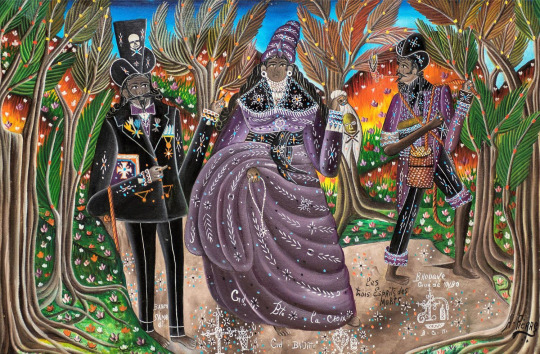
Baron Samedi, Grande Brigitte, and Guede Nibo, as portrayed by Andre Pierre.

Grann Brijitte, as portrayed by Amina Simeon.

Baron Samedi and Maman Brigitte, as portrayed by Gerard Paul.
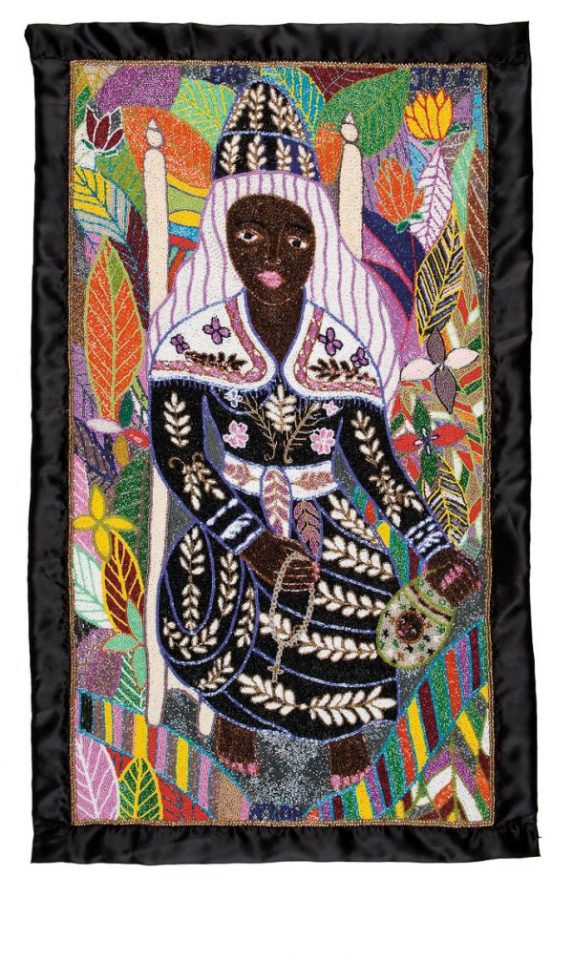
Grann Brijit, as portrayed by Roudy Azor.

Grann Brijit, as portrayed by Salnave Philippe-Auguste.
Where does the notion of a white Maman Brigitte come from?
In “Gran Brijit: Haitian Vodou Guardian of the Cemetery” (2010), Kerry Noonan examines the roots of the Vodou lwa Gran Brijit, and her connection to the Irish Saint Brigid. There are several parts I disagree with, but it is helpful as an overview.
In a key section, Noonan cites Milo Marcelin’s Mythologie Vodou Vol. 2 (1950). In this volume, Marcelin includes a two-page description of Maman Brigitte (Grande Brijitte). The first paragraph of this section reads as follows:
Grande Brijitte, femme de Baron-Samedi et mère des Guédé, est une négresse très vieille —c’est pourquoi on l’appelle grande (grand' mère). Elle est identifiée à Sainte Brigitte, patronne de l’Irlande; elle a pour reposoir un «cirouellier» (spondias purpurea L.) ou un figuier maudit marron (clusia rosea Jacq.) et, parfois, dans les cimetières, un amoncellement de pierres la représente. Ses jours sont le lundi et vendredi, sa couleur, le noir.
English Translation:
Grande Brijitte, wife of Baron-Samedi and mother of the Gede, is a very old Black woman – this is why she is called “grande” (grandmother). She is identified with Saint Brigid, patron saint of Ireland; she has as her resting place a “cironelle” (spondias purpurea L.) or an autograph tree (clusia rosea Jacq.) and, sometimes, in the cemeteries, a pile of black stones represents her. Her days are Monday and Friday, her color, black.
Noonan notes several similarities between Saint Brigid and Maman Brigitte, including similar ceremonies, similar offerings (notably, potatoes and chicken), and a shared association with crosses. She also notes circumstances where Saint Brigid becomes speechless, which is similar to Marcelin’s description of Maman Brigitte: “Grande Brijitte ne parle jamais.”
The full excerpt from Mythologie Vodou, Vol. II is found on pages 177-178, and included at the bottom of this article, in APPENDIX A.
Noonan also notes similarities between the Yoruba orisha Oya and Maman Brigitte. Moreover, the association between the cross and Maman Brigitte is not rooted in a European understanding of the cross, but an African one.
From Leslie Gerland Desmangles’ (1997) “African interpretations of the Christian cross in Vodun”:
“The symbol of the cross is central to Vodun's ceremonies…While it is true that the Catholic crosses in Haiti may well have been invested with Vodun meaning, the cross symbol in Vodun does not originate in Catholicism but in African mythology. In Dahomey, for example, the universe is conceived as a sphere transected by two mutually perpendicular and intersecting planes, which, perceived in a cross-section of the sphere, represent the arms of a cross…the cross symbol in Vodun cannot be seen as representing a symbolic relationship between Roman Catholicism and Vodun but indicates the retention of African religious elements on Haitian soil.”
The above applies to the lwa associated with liminality – especially Papa Legba, but also the lwa of the Dead, including Baron Samedi and Maman Brigitte.
From Benjamin Hebblethwaite (2021) A Transatlantic History of Haitian Vodou:
“The Cross of Crosses, mentioned in line 3, is the intersection of life and death. The center of the cross is where Bawon, Brijit, and the Gede take charge of the passage from life to death. The “Cross” is a crossroads (kafou) linking the living with the ancestors under the water.”
Noonan asserts that Maman Brigitte is identified with Saint Brigitte because of the influence of “Irish settlers and sailors and Breton priests". In one of the most objectionable sections of this article, Noonan characterizes the “Irish settlers” as “indentured servants”.
As indentured servants, Irish and Scottish people were sent to territories under the control of the British Empire. The British West Indies did not include present-day Haiti. Presumably, Noonan is referring to fugitive indentured servants, called “ingleses”. In “Irish Indentured Servants, Papists and Colonists in Spanish Colonial Puerto Rico” (2007), Jorge L. Chinea claims that “Puerto Rico, Hispaniola and Cuba became popular destinations for the fugitives.”
Chinea also describes how the Spanish repeatedly denied the Irish authorization to settle in Hispaniola during the late 1600s: “In this instance, their potential infringement on the Spanish American trade in a colony already heavily involved in contraband was a major reason for turning them down.”
Nowhere does Noonan mention the influence of Irish slave owners.
"The many Haitians and West Indians who trace their ancestry back to Africans transported on Irish-owned slave ships are living proof that the Irish have not always been the victims of history."
– Joe O’Shea (2012) “The Irish have not always been the victims of history”:
In “Irishness, Whiteness, Blackness, and Slavery in the Early Modern World” (2022), Jane Ohlmeyer describes how the Irish contributed to “one of the harshest systems of servitude in western history” during the 18th century:
“Of the 550 families involved in the French slave trade, seventeen had Irish surnames. One of the most successful Irish slavers was Antoine Walsh, the son of an Irish merchant who had settled in France in the later seventeenth century and married Marie O’Sheil/Shiell, whose grandfather had settled in France. Over the course of his career Walsh made forty slaving trips from Nantes and shipped more than 12,000 enslaved Africans. With his profits Walsh purchased a plantation for himself in the French colony of Saint-Domingue (modern day Haiti), which supplied up to seventy percent of all of the sugar sent to France.”
Rather than indentured servants, it is likely that Breton priests are behind the Maman Brigitte-Saint Brigid connection.
In “Rev. John J. Burke, the National Catholic Welfare Conference, and the American Occupation of Haiti” (2014) Donald J. Slawson describes how Roman Catholicism was brought to Haiti:
“The concordat between the Vatican and Haiti dated to 1860. From the time of Haitian independence in 1804 until that year, the condition of the Catholic Church in that country was deplorable…As early as 1834, Rome and Port-au-Prince had entered into negotiations to regularize the status of the Church in Haiti. President Fabre Geffrard finally achieved that goal…Given the nation’s colonial and cultural ties with France, the bishops and clergy came from Brittany.”
Noonan describes the importance of Saint Brigid to Breton priests: "Catholics in both Ireland and Brittany are devoted to the Irish St. Brigit of Kildare, and many churches are dedicated to her in both areas."
According to Sidney Mintz & Michel-Rolph Trouillot's "The Social History of Haitian Vodou", many features of modern Vodou took shape in the century that followed the Haitian Revolution. During this time period, Roman Catholics were sent to Haiti for the purpose of religious imperialism. They were openly hostile toward vodouisants, and sought to destroy African-based traditions.
This attitude persisted into the 20th century, as described by Melville Herskovits in Life in a Haitian valley (1964):
“The attitude of the Church toward vodun is one of intransigent hostility. The anger with which the priest preached his sermon on the Sunday morning following a vodun dance held close enough to town so that the sound of the drums, plainly audible, "disturbed" him the night long, clearly indicates how deeply the priests of the Church resent the worship of the African gods. In Mirebalais they tell how, at the instance of the Church, vodun rites were unmercifully suppressed by the Americans during the occupation, to whom it was represented as a potential focus for revolt. In the place huge bonfires were made of vodun drums painted and "dressed" in elaborate manner. Everything found in the humforts and the private houses of worship was confiscated, and the "thunder stones," necklaces of the devotees, and other sacred objects that would not burn were thrown into the Artibonite River. Today the Church takes full advantage of its status as the only recognized religious organization in Haiti to dictate the official position of government toward vodun.”
It is for this reason that several of the lwa have Europeanized names, including “Baron Samedi”. Maman Brigitte is not named after Saint Brigid because of friendships between African slaves and Irish indentured servants. Instead, it is because European priests imposed the worship of white saints onto a Black population.
The narrative that connects Maman Brigitte to indentured servants is a fiction invented by white people.
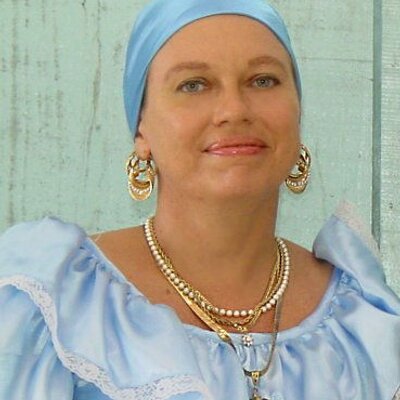
Pictured: Mambo Racine
“Maman Brigitte, the Mother of the Gedes” is a Google Groups conversation on alt.religion.orisha, dated Jun 16, 2001 - Jun 19, 2001. In this conversation, which may have only involved white people, there is an exchange between Mambo Racine and Kenaz Filan (at the time, named Kevin Filan).
The full conversation is included in APPENDIX B. The top post is the most relevant one:

Maman Brigitte is a manifestation of the Celtic Goddess Brigid. During the formative period of Haitian Vodou, many Scottish people were deported from Scotland to the Antilles because of the Stuart wars, and those Scots were the most traditionalist, the least Christianized. They were the ones who brought Brigid to Haiti.
During this time, blacks outnumbered whites about 4000 to one. This is a literal fact. So it is unlikely that those few whites could prevent Africans from having drum dances - it seems to me more likely that an uneasy truce obtained, you know, the whites said in effect, "Do your work and I will leave you alone."
At that time the whites most likely to participate in drum dances were of course the poor whites, not the few French elite whites. And among them, the most likely people to participate were the women - just the folks most likely to have preserved the service of Brigid.
(Before I go any further let me suggest that anyone who hasn't read Jayelle's "White Women in Vodou" do so!)
Now, the first woman buried in any cemetary is by definition Brigid, and the first man buried in any cemetary is by definition Baron. Of course when those drum-dancing poor Scottish women died they were buried in the same earth as Africans, and the agglomerative, pragmatic nature of Vodou as it developed would of course naturally incorporate Brigid, and metamorphose her into Maman Brigitte.
Now, to make Gede lwa, Maman Brigitte and Baron La Croix take souls from "under the water" and rebaptize them. That is why all Gede lwa have the last name La Croix, because their father is Baron La Croix. This is a real birth, out of the waters, Baron and Brigitte are not "adoptive parents", they are as much parents as any parent can be.
For more information on the travels of one Gede lwa, see "Biography of a Lwa" under the Special Topics heading on The VODOU Page. And for more information on ancestral lwa in general, see Vodou Lesson 2 under the Vodou Lesson heading on The VODOU Page.
Peace and love,
Bon Mambo Racine Sans Bout Sa Te La Daginen
"Se bon ki ra" - Good is rare Haitian Proverb
The VODOU Page - http://members.aol.com/racine125/index.html
It goes without saying, this is not well-researched.
This is how Maman Brigitte became something of a “patron saint” for white people involving themselves in Vodou, at the expense of Black women.
It feels childish that I even have to say this, but I don’t want anyone to send this woman hate. I don’t think it is fair to rake someone over the coals for saying something stupid over 20 years ago. Additionally, it would be unfair to pin the blame on this one person, as she is not necessarily the originator and it was clearly a group of people who believed this. Rather, it is important to learn from past mistakes by examining the cause and effect.
This false narrative didn’t stay confined to a small group of people. It spread into publications, which are now sitting in libraries and websites all over the internet.
Recall the description I included at the beginning:
In Voodoo, Ma'man Brigit (Grann Brigitte, Manman, Manman Brigit, Manman Brijit) is the mother of cemeteries, the loa of money and death, and the wife of Baron Samedi. She may be related to the "triple" Celtic goddess of poetry, smithcraft, and healing, Brigid/St. Brigit, as her name is Irish in origin. She is usually depicted as a white woman.
This is an excerpt from Denise Alvarado’s (2009) The Voodoo Hoodoo Spellbook. This is one of several popular books that mischaracterizes Maman Brigitte in this manner. Artists, authors, and other creators read these books, which informs their character designs.
See how Maman Brigitte is typically portrayed in popular media:
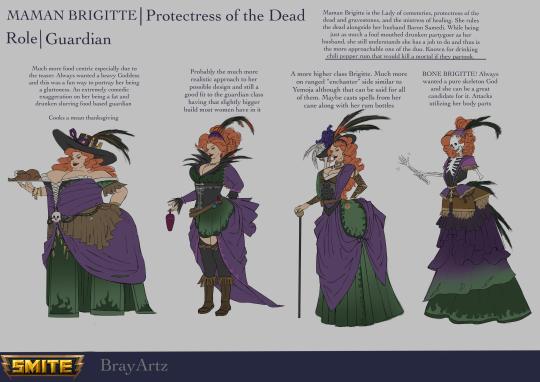

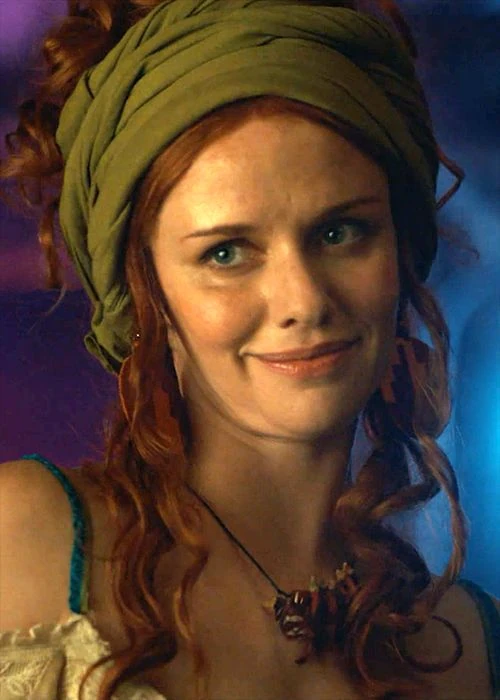

This is not the fault of this actress, at all. American Gods was actually praised for its portrayal of African spiritualities! At least, by some people… There could be intense internet discourse about how bad this portrayal was, which I am not privy to because I don’t use Twitter…
I genuinely think the creative team behind American Gods (and possibly Smite…I wouldn’t know because I don’t play…) made a serious attempt to research New Orleans Voodoo. It is not because they didn’t care or try to research this topic; rather, it speaks to how widespread and deep-rooted this problem is.
This matters because it contributes to colorism and racism against women. All across popular media, dark-skinned Black women are denigrated and erased, which impacts how people see and treat Black women in real life. Whenever they do appear, they are often stereotyped and/or excessively criticized by audiences, who can’t be normal around a “twofer minority”. This pattern has been the norm for most of human history. It went uncriticized until very recently, and continues into the present day.
More to the point, the lwa are sacred to Vodouisants of Haitian heritage. Haiti Vodou is embedded in the history of Haiti – the first nation to permanently ban slavery. This was won through a bloody Revolution, which is why the lwa are these warrior-like gods of justice. The whitewashing of religious figures is disgraceful–especially the lwa of Haiti.
There are regional differences in Haitian Vodou, which is why accounts from different, credible sources can vary. Unfortunately, this is used as an excuse to invent falsehoods about the lwa. It is inaccurate to describe Maman Brigitte as a mere manifestation of the European saint or goddess, as this erases her African and Caribbean elements. Instead of viewing her as European or African in origin, Maman Brigitte is best described as a lwa that is uniquely indigenous to Haiti.
Haitian Vodou is a part of Haitian national heritage, and the lwa are ancestral to the Haitian people. We should respect the depiction of Maman Brigitte as she is portrayed by Haitians.
She is not this:

But this:
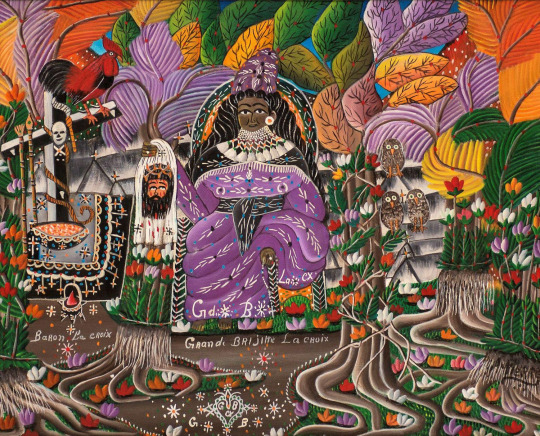
CITATION LIST:
Alvarado, Denise. Voodoo hoodoo spellbook. Weiser Books, 2011: p. 34.
Chinea, Jorge L. "Irish Indentured Servants, Papists and Colonists in Spanish Colonial Puerto Rico, ca. 1650-1800." Irish Migration Studies in Latin America 5.3 (2007): pp. 171-81. https://www.irlandeses.org/0711.pdf#page=35
Desmangles, Leslie Gerald. “African Interpretations of the Christian Cross in Vodun.” Sociological Analysis, vol. 38, no. 1, 1977, pp. 13–24. JSTOR, https://doi.org/10.2307/3709833. Accessed 9 Sept. 2024.
Hebblethwaite, Benjamin. A Transatlantic History of Haitian Vodou: Rasin Figuier, Rasin Bwa Kayiman, and the Rada and Gede Rites. United States, University Press of Mississippi, 2021. p. 204
Herskovits, Melville J.. Life in a Haitian Valley. United States, Octagon Books, 1964: pp. 289-290. https://archive.org/details/lifeinhaitianval0000hers/page/288/mode/2up
Marcelin, Milo. "Mythologie vodou (Rite Arada), Volume II." Pétionville: Éditions Canapé Vert (1950). pp. 177-178
Mintz, Sidney & Trouillot, Michel-Rolph. “The Social History of Haitian Vodou”. In Cosentino, Donald. Sacred Arts of Haitian Vodou. United States, UCLA Fowler Museum of Cultural History, 1995: pp. 123-147. https://ghettobiennale.org/files/Trouillot_Mintz_LOW.pdf
Noonan, Kerry. “Gran Brijit: Haitian Vodou Guardian of the Cemetery.” In Goddesses in World Culture: Volume 3, Australia and the Americas, edited by Patricia Monoghan, 123-133. Denver, Colorado: Praeger, 2011
Ohlmeyer, Jane. “Irishness, Whiteness, Blackness, and Slavery in the Early Modern World.” American Journal of Irish Studies, vol. 17, 2022, pp. 5–38. JSTOR, https://www.jstor.org/stable/27290673. Accessed 9 Sept. 2024.
Slawson, Douglas J. “Rev. John J. Burke, the National Catholic Welfare Conference, and the American Occupation of Haiti (1915-34).” The Catholic Historical Review, vol. 100, no. 3, 2014, pp. 514–54. JSTOR, http://www.jstor.org/stable/43898675. Accessed 9 Sept. 2024.
APPENDIX A: FULL EXCERPT FROM MILO MARCELIN’S (1950) MYTHOLOGIE VODOU VOL. 2:
GRANDE BRIJITTE
Grande Brijitte, femme de Baron-Samedi et mère des Guédé, est une négresse très vieille —c’est pourquoi on l’appelle grande (grand' mère). Elle est identifiée à Sainte Brigitte, patronne de l’Irlande; elle a pour reposoir un «cirouellier» (spondias purpurea L.) ou un figuier maudit marron (clusia rosea Jacq.) et, parfois, dans les cimetières, un amoncellement de pierres la représente. Ses jours sont le lundi et vendredi, sa couleur, le noir.
Grande Brijitte est aussi puissante que son mari. Parfois elle préside au cimetière. Si la première personne enterrée dans un cimetière nouvellement construit est un homme, on dit qu'il est Baron-Samedi et il est le maître de ce cimetière; si c’est une femme, elle est Grande Brijitte et elle est maîtresse de ce cimetière.
Les cas de possessions de Grande Brijitte sont fort rares. Quand elle possède une personne, celle-ci est comme morte. On lui bande la mâchoire avec un foulard noir, on lui met du coton aux oreilles et aux narines, on la couvre d'un drap blanc, on l'asperge de clairin (rhum blanc) et on chante:
Ou dit Manman Brijitte couché,
L’ap’ dômi!
Ou dit Manman Brijitte couché,
L’ap’ dômi!
Lô-r la réveillé,
Dèniè hounsi dô-bas!
D'leau lan gé Manman Brijitte!
Lô-r la réveillé
Dèniè hounsi dô-bas!
Tu dis que Maman Brijitte est couchée,— Et qu'elle dort! — Tu dis que Maman Brijitte est couchée, — Et qu'elle dort! — Quand elle se réveillera,— Toutes les hounsis (serviteurs du temple) seront dos bas! — Il y a de l'eau dans les yeux de Maman Brijitte! — Lors-qu’elle se réveillera, — Toutes les hounsis seront dos bas!
Grande Brijitte ne parle jamais. Quand elle se retire de son cheval (de sa possédée), on chante parfois cette chanson:
Manman Brijitte alé
Guingue, gongue!
Manman Brijitte alé
Guingue, gongue!
Manman Brijitte est partie – Guingue, gongue (tintement de la cloche: le glas funèbre!) – Maman Brijitte est partie – Guingue, gongue!
Parfois Grande Brijitte et Baron-Samedi apparaissent ensemble. On revêt ce dernier d'un linceul, on lui met aussi du coton aux oreilles et aux narines. Il s'assied sur le lit où est étendue sa femme. Lui non plus ne parle pas, ne boit pas, ne fume pas. On les veille alors, comme on fait pour les morts.
Une invocation à Grande Brijitte:
Brave, oh!
Alé rhélé Manzè Brijitte pou mouin!
M’ prall’ Thomazeau!
M’ pa gaingnin Manman,
Qui pou palé pou mouin!
M’ pa gaingnin Papa,
Qui pou palé pou mouin!
Brave, oh!
Alé rhélé Manzè Brijitte pou mouin!
M’ prall’ Thomazeau!
Brave (Guédé), oh! — Va appeler Mam'zelle Brigitte pour moi! — Je vais à Thomazeau (ville du Département de l’Ouest)! — Je n’ai pas de Maman, — Pour prendre ma défense! — Je n’ai pas de Papa, — Pour prendre ma défense! — Brave, oh!— Va chercher Mam’zelle Brijitte pour moi! — Je vais à Thomazeau!
Le menu rite du repas de Grande Brijitte est composé de patates, de bananes (plantain), du hareng-sel et de la morue boucanés, du maïs et des pistaches grillés, du gros-sirop (sirop de canne à sucre). On lui offre du clairin (rhum blanc) et en sacrifice, des poules noires.
APPENDIX B: “Maman Brigitte, the Mother of the Gedes”
Racine125
Jun 16, 2001, 4:37:00 PM
to
Maman Brigitte is a manifestation of the Celtic Goddess Brigid. During the
formative period of Haitian Vodou, many Scottish people were deported from
Scotland to the Antilles because of the Stuart wars, and those Scots were the
most traditionalist, the least Christianized. They were the ones who brought
Brigid to Haiti.
During this time, blacks outnumbered whites about 4000 to one. This is a
literal fact. So it is unlikely that those few whites could prevent Africans
from having drum dances - it seems to me more likely that an uneasy truce
obtained, you know, the whites said in effect, "Do your work and I will leave
you alone."
At that time the whites most likely to participate in drum dances were of
course the poor whites, not the few French elite whites. And among them, the
most likely people to participate were the women - just the folks most likely
to have preserved the service of Brigid.
(Before I go any further let me suggest that anyone who hasn't read Jayelle's
"White Women in Vodou" do so!)
Now, the first woman buried in any cemetary is by definition Brigid, and the
first man buried in any cemetary is by definition Baron. Of course when those
drum-dancing poor Scottish women died they were buried in the same earth as
Africans, and the agglomerative, pragmatic nature of Vodou as it developed
would of course naturally incorporate Brigid, and metamorphose her into Maman
Brigitte.
Now, to make Gede lwa, Maman Brigitte and Baron La Croix take souls from "under
the water" and rebaptize them. That is why all Gede lwa have the last name La
Croix, because their father is Baron La Croix. This is a real birth, out of
the waters, Baron and Brigitte are not "adoptive parents", they are as much
parents as any parent can be.
For more information on the travels of one Gede lwa, see "Biography of a Lwa"
under the Special Topics heading on The VODOU Page. And for more information
on ancestral lwa in general, see Vodou Lesson 2 under the Vodou Lesson heading
on The VODOU Page.
Peace and love,
Bon Mambo Racine Sans Bout Sa Te La Daginen
"Se bon ki ra" - Good is rare
Haitian Proverb
The VODOU Page - http://members.aol.com/racine125/index.html
Kevin Filan
Jun 17, 2001, 3:43:50 PM
to
Thanks for a fascinating essay on Maman Brigitte. While I can't comment
on her place in Haitian Vodou, I do have some knowledge of Scots and
British history, as well as a bit of experience doing scholarly
research. While I think you make a couple of questionable assertions,
you also have raised some interesting points.
Racine125 wrote:
>
> Maman Brigitte is a manifestation of the Celtic Goddess Brigid. During the
> formative period of Haitian Vodou, many Scottish people were deported from
> Scotland to the Antilles because of the Stuart wars, and those Scots were the
> most traditionalist, the least Christianized. They were the ones who brought
> Brigid to Haiti.
http://www.learner.org/biographyofamerica/prog13/feature/index_text.html
Tells us the first African slaves in the New World arrived in Hispaniola
in 1501... and the first slave rebellion in Hispaniola was in 1522. By
that time Scotland had been Christian for over a thousand years. While
Neopagans love to speculate about isolated villages practicing "the Olde
Pagan Customs" well into the 20th century, I've yet to see any evidence
of same. I certainly doubt VERY strongly that there were any Scotsmen
of that time, no matter how isolated a little town they came from, who
would have considered themselves "Brigid worshippers." I'm even
inclined to think that by the time of the Stuart Wars poor White
indentured servants were largely becoming a thing of the past, as the
Slave routes became well-established and the full horror of that
machinery was coming into operation. There were certainly Catholic
Scots who got the heck outta Dodge during the Stuart Wars: many of them
wound up in Catholic France or some of the French colonies. But I'm not
sure that they came to St. Dominique as indentured servants.
Here's an excerpt from http://www.scotlandspast.com/religion.htm which
shows that Christianity was well established in Scotland by the 8th
century: the whole site, BTW, is fascinating and well worth a read.
* * * * *
The first named missionary to Scotland is Ninian who is referred to in
an aside by Bede while discussing the conversion of the Picts in his
Ecclesiastical History of the English People written in 731 AD. In this
aside he says 'The southern Picts, who live on this side of the
mountains, are said to have abandoned the errors of idolatry long before
this date and accepted the true Faith through the preaching of Bishop
Ninian, a most reverend and holy man of British race, who had been
regularly instructed in the mysteries of the Christian Faith in Rome.
Ninian's own Episcopal see, named after Saint Martin and famous for its
stately church, is now held by the English, and it is here that his body
and those of many saints lie at rest. The place belongs to the province
of Bernicia and is commonly known as Candida Casa, the White House,
because he built the church of stone, which was unusual among the
Britons.' Ninian is also dealt with in Miracula Nyniae Episcopi which
also mentions a king called Tudwal, historians have used the above
evidence to date Ninian to the 5th century, about the same time as
Patrick. There have been many suggestions that Ninian operated much
further north than Galloway and dedications to him can be found as far
north as Fife and even into Angus. Although the term missionary has been
used here it is likely that Christianity of some kind already existed
and that Ninian, Columba and the other early saints were not
missionaries in the modern sense.
* * * * * *
That being said, there certainly were indentured White servants in Haiti
during the earliest days of its colonization. From
http://208.154.71.60/bcom/eb/article/6/0,5716,108616+21,00.html
* * * * *
As the English, French, Dutch, and, to a lesser extent, the Danes
colonized the smaller West Indian islands, these became plantation
settlements, largely cultivated by blacks. Before the latter arrived
in great numbers, the bulk of manual labour, especially in the English
islands, was performed by poor whites. Some were indentured, or
contract, servants; some were redemptioners who agreed to pay ship
captains their passage fees within a stated time or be sold to bidders;
others were convicts. Some were kidnapped, with the tacit approval of
the English authorities, in keeping with the mercantilist policy that
advocated getting rid of the unemployed and vagrants. Black slavery
eventually surpassed white servitude in the West Indies.
* * * * *
By the time of the Code Noir, there was some effort made to distinguish
between Blacks, mulattos, and Whites: I suspect by that time most of the
ancestors of the early indentured Whites were considered mulatto at
best. Some of the worst buccaneers of the time were headquartered on
the Island of Tortuga, an isle populated by creoles, escaped indentured
servants, escaped slaves and other "lawless riffraff." So there was
definitely mingling of the races and mingling of the cultures.
> During this time, blacks outnumbered whites about 4000 to one. This is a
> literal fact.
I was under the impression it was more like 20 to one, but if you could
cite some source which says otherwise I'd certainly be open to
correction.
> So it is unlikely that those few whites could prevent Africans
> from having drum dances - it seems to me more likely that an uneasy truce
> obtained, you know, the whites said in effect, "Do your work and I will leave
> you alone."
It generally appears that slave owners were, if anything, *hostile* to
attempts to convert their slaves. They didn't want to deal with the
responsibility of teaching these savages, never mind giving them time
off to go to church. While they punished anything which smacked of
rebellion with truly horrendous savagery, they of course weren't able to
stop every drum dance or religious service.
> At that time the whites most likely to participate in drum dances were of
> course the poor whites, not the few French elite whites. And among them, the
> most likely people to participate were the women - just the folks most likely
> to have preserved the service of Brigid.
This involves a whole bunch of assumptions, some of which may not be
true. I think the assumption that the service of Brigid was preserved
is a dubious one at best. (I'm also not sure that Brigid was
particularly popular in Scotland: I was of the impression that she was
more favored in Ireland). And were White women regularly participating
in erotically-charged (at least in the popular White imagination of the
time) drumming rituals? While the Code Noir allowed intermarriage,
there were certainly social taboos against this, particularly against
White woman sleeping with Black men.
> (Before I go any further let me suggest that anyone who hasn't read Jayelle's
> "White Women in Vodou" do so!)
An excellent and moving piece which describes what Maman Brigitte means
to Jayelle and how she has integrated Maman Brigitte into her own life.
I have no interest in "debunking" Jayelle's personal mythology, or in
"disproving" her belief that her Maman Brigitte is related to the Celtic
Brigitte. Jayelle seems like a very nice and very intelligent person:
if her service of Brigitte does good things for her, then I wish her
well. I can respect the opinions of a devout, sincere Moslem, without
believing that the Koran is the direct word of God and that Mohammed is
the seal of the prophets.
That being said: I think one of the big problems facing Neopagan
theology today is flabby scholarship. "Authorities" pull assertions out
of their posteriors without any kind of evidence: other "authorities"
then point to these assertions as "proof." I saw a recent claim, for
instance, that the "Black Madonna" found throughout Europe is really a
survival of Isis and Horus worship. I didn't see any evidence backing
that claim up -- just a bald-faced assertion. I could just as easily
claim the Black Madonna was a survival of Parvati holding the Infant
Krishna, or of the infant Guatama being held by his Mother. I'm sure
that I could find a "Mother holding a Child" figure in the art of just
about EVERY culture: does that prove that the Black Madonna is a
survival of Inuit rule over Europe, or that Europe was once occupied by
South Sea Islanders? Speculation is one thing: so long as you clearly
say "This is what I believe," or "This is one possible explanation," I'm
not inclined to complain. But once you and others start presenting your
speculation as Historical Fact, you can run into all kinds of problems.
> Now, the first woman buried in any cemetary is by definition Brigid, and the
> first man buried in any cemetary is by definition Baron. Of course when those
> drum-dancing poor Scottish women died they were buried in the same earth as
> Africans, and the agglomerative, pragmatic nature of Vodou as it developed
> would of course naturally incorporate Brigid, and metamorphose her into Maman
> Brigitte.
You're assuming a lot here again. I'm not saying that you're wrong, but
I'd like to see some scholarship regarding the ethnic makeup of
indentured servants in Haiti, the interactions between indentured
servants and African slaves, and the religious beliefs of indentured
White servants in Haiti. As I said before, there certainly were
intermarriages and interrelationships between poor Whites (particularly
escaped indentured servants) and African slaves. And if you can point
me in the direction of evidence that Brigid-worship survived in Scotland
as late as the 17th century, I would be greatly appreciative.
Peace
Kevin Filan
--
Now in the graveyard of my secrets there's a hope buried beneath
All this talk of peace and righteousness as left me weary beyond belief
And there's this unwanted mistress in my bed late at night
She says "I know you're a criminal
-- you been on death row all your life."
- Bill Mallonee
Racine125
Jun 17, 2001, 4:34:43 PM
to
In article <[email protected]>, Kevin Filan
<[email protected]> writes:
>..the first African slaves in the New World arrived in Hispaniola
>in 1501... and the first slave rebellion in Hispaniola was in 1522....
I don't mean that Scottish deportees were in Haiti from the
beginning of the slave trade! The Stuart wars took place later,
in the mid-1700's, which is in plenty of time to contribute to
the formation of the contemporary Vodou religion. Not only
that, but Scottish people were being deported to the West
Indies including Haiti long before the Stuart wars - that is where
all those Jamaicans get names like Fitzwilliam and Fitzroy, and
that is why there are Haitians named Bailly.
> I certainly doubt VERY strongly that there were any Scotsmen
>of that time, no matter how isolated a little town they came from, who
>would have considered themselves "Brigid worshippers."
Oh, I don't doubt it for a moment, I bet Scots*women* kept
Brigid alive in their hearts - that is no different from the modern
Haitians in the north of Haiti who are hereditary Muslims!
Documents written by Christians claiming that the "Picts are
Christianized" mean as much to me as modern documents
written by Christians in Haiti claiming that the majority of
Haitians have renounced Vodou.
The population statistics I quoted are from historical documents
of the time, it's on the 'Net in a few places, I will look and see
if I can find them again.
There is no doubt that Brigitte is a manifestation of Brigid, although
we may go rooting around a bit to decide exactly how and when.
Like Bob Marley said, "Half the story has never been told."

Kevin Filan
Jun 18, 2001, 11:58:10 PM
to
In article <[email protected]>, Racine125 says...
>
>In article <[email protected]>, Kevin Filan
><[email protected]> writes:
>
>>..the first African slaves in the New World arrived in Hispaniola
>>in 1501... and the first slave rebellion in Hispaniola was in 1522....
>
>I don't mean that Scottish deportees were in Haiti from the
>beginning of the slave trade! The Stuart wars took place later,
>in the mid-1700's, which is in plenty of time to contribute to
>the formation of the contemporary Vodou religion. Not only
>that, but Scottish people were being deported to the West
>Indies including Haiti long before the Stuart wars - that is where
>all those Jamaicans get names like Fitzwilliam and Fitzroy, and
>that is why there are Haitians named Bailly.
I don't think you were seeing a lot of indentured servitude in St. Dominique by
the 1750s. At that stage in the game they were mostly using the "labor camp"
model: buy slaves, work them to death, repeat as necessary. For the most part
the farms were divided into massive plantations where indentured servants would
be working as overseers at best. It's highly unlikely that any overseers were
hanging out at African drum dances ... in fact, I'd say the overseers would have
been among the first killed when the rebellion started.
I think a more promising approach might be to compare some of the folk beliefs
of the early French settlers, particularly any settlers from the Breton area,
and compare them with the beliefs and rituals found in Haiti today around Maman
Brigitte. For that I'd look no later than the early 18th century, before the
Code Noir and before the disenfranchisement of the Mulattos. At that period you
would have had a prosperous Creole culture where you might have seen that kind
of interaction between Whites and Blacks and their belief systems. Later you
get much more a "state of siege" and an effort to keep the systems separate.
(You can still see the psychological effects of this among Haiti's mulatto
elite). And then, during and after the Revolution, the Whites who weren't
killed out got the heck out of Dodge: after that time there wasn't enough of a
white presence, IMO, to have that kind of an impact on the development of Vodou.
I just picked up W.Y. Evans-Wentz's 1911 book *The Fairy-Faith in Celtic
Countries.* While he engages in a fair bit of psychical and theosophical
speculation, he also did a goodly amount of field work in the British Isles and
in Breton. He was also a disciple of the great American philosopher William
James: I can definitely see the influence of *Varieties of Religious Experience*
in the preconceptions he brings to the table when compiling his data. From what
I've read so far, the book is fascinating and thought-provoking, although you
may want to keep a salt shaker handy when reading.
http://www.sacred-texts.com/neu/celt/ffcc/ has an online edition of this book.
One thing I've noted is that Bretons strongly identify the Fae folk with the
spirits of the dead, arguably more so than other Celtic peoples. If this is
true (and, again, I've not done the research to verify all of Evans-Wentz's
claims), then it might be an explanation of how a goddess frequently assoicated
with the Fairy Kingdom became the Queen of the Dead.
When are Maman Brigitte and the Baron first mentioned in print? I know that the
scholarship on Vodou is woefully thin, but in present day Vodou these are two of
the most popular and well-known Lwa. If we could get some idea as to how long
Brigitte has been served, perhaps we'd get some better clue as to her origins.
>> I certainly doubt VERY strongly that there were any Scotsmen
>>of that time, no matter how isolated a little town they came from, who
>>would have considered themselves "Brigid worshippers."
>
>Oh, I don't doubt it for a moment, I bet Scots*women* kept
>Brigid alive in their hearts - that is no different from the modern
>Haitians in the north of Haiti who are hereditary Muslims!
The broker who got us our apartment was a Lebanese Haitian: I've gathered there
is also a Syrian population in Haiti as well. Are these the Muslims of whom you
speak?
I would expect that most of the peasants from France, Scotland, England and
Ireland would have considered themselves Catholics. They might pay homage to
"saints" like Brigid in ways which reflected the pre-Christian worship of
Brigid... but they would likely consider this Catholic. While I am open to the
possibility -- and would love to see it, actually -- I have not yet seen any
evidence of widespread survival of pre-Christian religion in Europe,
particularly a pre-Christian survival which recognized itself as such. I
suspect the situation resembled African-American Hoodoo: lots of bits and pieces
from an earlier structure, but lacking major amounts of the underlying
philosophy of that structure and incorporating many Christian ideas.
>Documents written by Christians claiming that the "Picts are
>Christianized" mean as much to me as modern documents
>written by Christians in Haiti claiming that the majority of
>Haitians have renounced Vodou.
What those documents prove is that there was a pretty established Christian
community in Scotland as early as the 8th century. It doesn't prove that the
pre-Christian customs had died out entirely ... indeed, if Evans-Wentz's field
research was at all accurate, many of them survived as late as the 19th and
early 20th century. What it means is that we can expect these pre-Christian
myths to have incorporated a good deal of Christian mythology by the time St.
Dominique was being colonized.
>The population statistics I quoted are from historical documents
>of the time, it's on the 'Net in a few places, I will look and see
>if I can find them again.
>
>There is no doubt that Brigitte is a manifestation of Brigid, although
>we may go rooting around a bit to decide exactly how and when.
>Like Bob Marley said, "Half the story has never been told."
I'm not saying that you're wrong here, although I think you may be pointing a
bit in the wrong direction. I'm definitely interested in hearing more about why
Maman Brigitte "comes from England" and for how long this identification has
been made. Do you know any other Maman Brigitte songs? Looking at those lyrics
might help to uncover other clues as to Brigitte's origin.
I know we have a few people on here with some knowledge of Celtic culture and
mythology. Any recommendations for good books on the subject which avoid the
Standard Newage Pitfalls?
>Peace and love,
>
>Bon Mambo Racine Sans Bout Sa Te La Daginen
>
>"Se bon ki ra" - Good is rare
> Haitian Proverb
>
>The VODOU Page - http://members.aol.com/racine125/index.html
Peace
Kevin Filan
"My country, right or wrong," is a thing that no patriot would think of
saying expect in a desperate case. It is like saying, "My mother,
drunk or sober." - G.K. Chesterton
Other
Jun 19, 2001, 6:05:57 AM
to
<snip>
> There is no doubt that Brigitte is a manifestation of Brigid, although
> we may go rooting around a bit to decide exactly how and when.
> Like Bob Marley said, "Half the story has never been told."
>
Don't forget that there is a Catholic Saint, St. Bridget who is clearly a
Christianized version of the Goddess Brigid.
--
Troy
"Self, I could do bad pencil drawings of Mr. Spock!"-Robin Wood
Racine125
Jun 19, 2001, 9:16:10 AM
to
In article <[email protected]>, Kevin
Filan<[email protected]> writes:
>I don't think you were seeing a lot of indentured servitude in St. Dominique
>by
>the 1750s. At that stage in the game they were mostly using the "labor camp"
>model: buy slaves, work them to death, repeat as necessary.
They who? Think again, Kevin - wealthy French plantation owners
did not soil their shoes going down to the cane fields or the indigo
patch or whatever. That work was done by poor whites and some
"trusted blacks" usually Kongo men because they were considered
by whites the most likely to betray their own people.
>It's highly unlikely that any overseers
>were
>hanging out at African drum dances ...
To the contrary - where else would they hang out? The fancy
whites wouldn't have anything to do with them. I want to stress
again and again the incredibly high numerical disparity between
blacks and whites, it wasn't like the USA, whites were few and
far between, and they had to have an "understanding" with blacks
who outnumbered them vastly (By the way the source of that
population data is online somewhere and I will keep trying to find
it and give it to you). And also remember that the most likely
participants were the women! These were not refined, constrained
Frenchwomen, these were rough, lower class independant
Celtic women accustomed to taking responsibility for themselves.
Now, faced with a choice between some boring white guy and
some big handsome Ashanti or Ibo, I know who I would rather
hang out with! LOL!
> in fact, I'd say the overseers would
>have
>been among the first killed when the rebellion started.
No, that came later - in the beginning there were groups of blacks
who protected whites whom they felt had done their best to protect
blacks, sometimes even to the point of battling for them, getting
them out of the country... it was Dessalines who brought on that
mentality that led to pregnant white women being split open
and their fetuses pulled out for the purposes of general amusement,
that kind of thing. In fact at one point he promised a large group
of white women and children safe passage back to France, and
then when they assembled, he had his men cut them to pieces
with swords because he "wouldn't waste the bullets".
>I think a more promising approach might be to compare some of the folk
>beliefs
>of the early French settlers, particularly any settlers from the Breton area,
>and compare them with the beliefs and rituals found in Haiti today around
>Maman
>Brigitte.
That might have been a part of it too! But you know, the Vodou
song which refers to the geographical origins of Maman Brigitte says
that "Maman Brigitte, li soti nan anglete", anglete being properly
"England" but by extension the British Isles.
>One thing I've noted is that Bretons strongly identify the Fae folk with the
>spirits of the dead, arguably more so than other Celtic peoples. If this is
>true (and, again, I've not done the research to verify all of Evans-Wentz's
>claims), then it might be an explanation of how a goddess frequently
>assoicated
>with the Fairy Kingdom became the Queen of the Dead.
Brigid was identified with the dead in her own country, and with healing
and smithcraft too.
>>Oh, I don't doubt it for a moment, I bet Scots*women* kept
>>Brigid alive in their hearts - that is no different from the modern
>>Haitians in the north of Haiti who are hereditary Muslims!
>
>The broker who got us our apartment was a Lebanese Haitian: I've gathered
>there
>is also a Syrian population in Haiti as well. Are these the Muslims of whom
>you
>speak?
No, I am talking about black people in the north of Haiti whose
ancestors were Muslims when they came over from Africa. Their
contemporary descendants remain Muslims until present, and the
anthropologists are having a field day with them! LOL!
>>Documents written by Christians claiming that the "Picts are
>>Christianized" mean as much to me as modern documents
>>written by Christians in Haiti claiming that the majority of
>>Haitians have renounced Vodou.
>
>What those documents prove is that there was a pretty established Christian
>community in Scotland as early as the 8th century. It doesn't prove that the
>pre-Christian customs had died out entirely ... indeed, if Evans-Wentz's
>field
>research was at all accurate, many of them survived as late as the 19th and
>early 20th century.
So there.
>I'm not saying that you're wrong here, although I think you may be pointing a
>bit in the wrong direction. I'm definitely interested in hearing more about
>why
>Maman Brigitte "comes from England" and for how long this identification has
>been made. Do you know any other Maman Brigitte songs? Looking at those
>lyrics
>might help to uncover other clues as to Brigitte's origin.
Of course I know more songs for Maman Brigitte, but none of them
say anything about her origin.
Kathy Latzoni
Jun 19, 2001, 10:10:50 AM
to
In article <[email protected]>, Racine125 says...
>
>In article <[email protected]>, Kevin
>Filan<[email protected]> writes:
>
>>I don't think you were seeing a lot of indentured servitude in St. Dominique
>>by
>>the 1750s. At that stage in the game they were mostly using the "labor camp"
>>model: buy slaves, work them to death, repeat as necessary.
>
>They who? Think again, Kevin - wealthy French plantation owners
>did not soil their shoes going down to the cane fields or the indigo
>patch or whatever. That work was done by poor whites and some
>"trusted blacks" usually Kongo men because they were considered
>by whites the most likely to betray their own people.
Hmm. Why were the Kongo [as opposed to Africans of other origins] considered the
"most likely to betray their own people"? <:/
I'd be interested in seeing your sources for this information...
>Brigid was identified with the dead in her own country, and with healing
>and smithcraft too.
>
In my own [somewhat casual] studies of Brigid, I have heard her identified with
all of these things as well -- but again, this has mostly come from pagan or
women's-spirituality books and websites, which often don't give many academic
citations, or statistics, to back up the assertions they make. [Yes, I'm
familiar with the quote about "lies, damned lies and statistics" ;) ... but that
would at least provide some primary research for us to evaluate.]
Your own reading has probably been more extensive than mine: are you able to
give us some more "hard facts" to support these conclusions here?
KL
Racine125
Jun 19, 2001, 11:31:52 AM
to
In article <[email protected]>, Kathy
Latzoni<[email protected]> writes:
>Hmm. Why were the Kongo [as opposed to Africans of other origins] considered
>the
>"most likely to betray their own people"? <:/
>
>I'd be interested in seeing your sources for this information...
Oh dear, another bibliography search, huh? There are actually quite a
few references to the "execrable Congos" and how other ethnic
groups scorned them because they would sell out incipient rebellions,
all sorts of stuff.
There are echoes of this kind of thing in current Haitian parlance too -
for instance "owsa" (Hausa) means "pickpocket", and apparently
Hausas had a reputation for being lightfingered in Africa as well.
I am getting on the plane very shortly and won't be able to look it
up for you but the references abound, it won't be hard for you to find.
#commentary#maman brigitte (hazbin hotel)#there’s little evidence for this so I leave it out of the main body: In Voodoo: An African American Religion (2024) Anderson briefly notes#that the ‘Mama You’ of New Orleans Voodoo might be Maman Brigitte. emphasis on 'might'. there’s so little record of ‘Mama You’ it’s hard to#say and probably wrong but it would be interesting if it was true...#To my knowledge the earliest recorded list of the lwa can be found#in Duverneau Trouillot’s (1885) Esquisse ethnographique: le vaudoun#Another useful text might be Benjamin Hebblethwaite’s (2021) A Transatlantic History of Haitian Vodou#I don’t have access to either text but they could pertain to the history and origins of Maman Brigitte (Grann Brijitte)
2 notes
·
View notes
Text
Tetsuna's Kinktober Finale: Shipping Edition
#knb#kuroko's basketball#tsc#shadowhunters#the shadowhunter chronicles#shadowhunter chronicles#sk#shaman king#vk#vampire knight#hdn#hyperdimension neptunia#free!#free! iwatobi swim club#free! anime#free! the final stroke#free! dive to the future#midorima shintarou#takao kazunari#midorima x takao#kit herondale#ty blackthorn#kit x ty#haruka nanase#makoto tachibana#makoharu#jeanne x ren#ren tao#jeanne tao#maria kurenai
10 notes
·
View notes